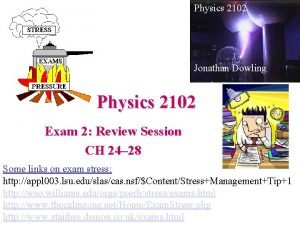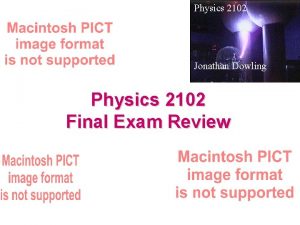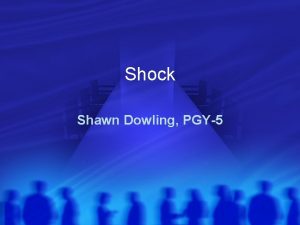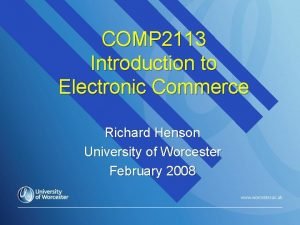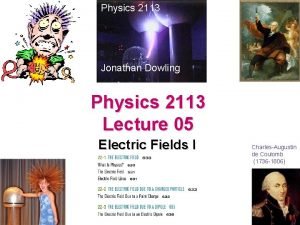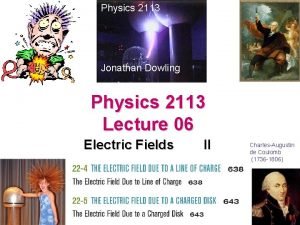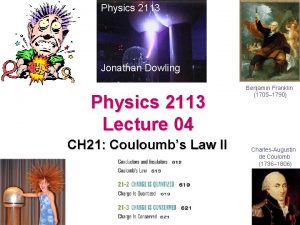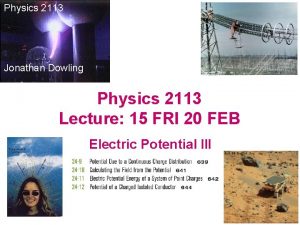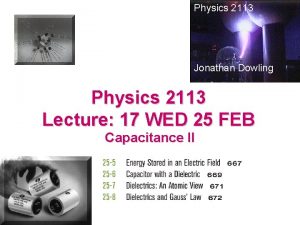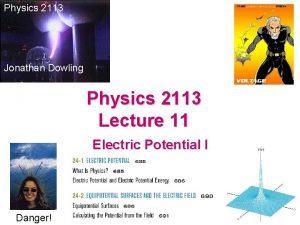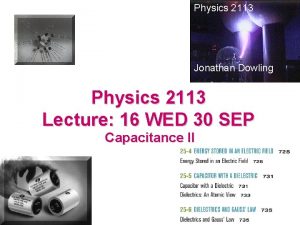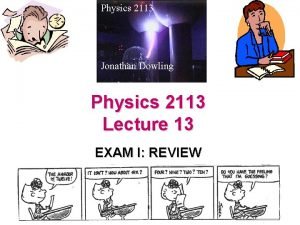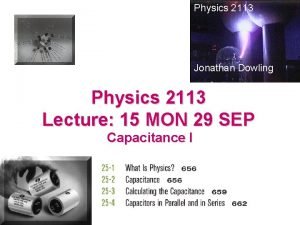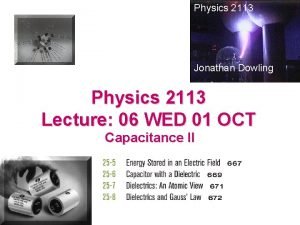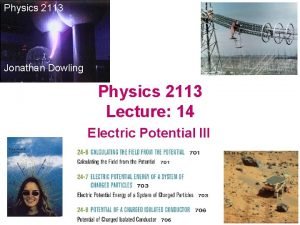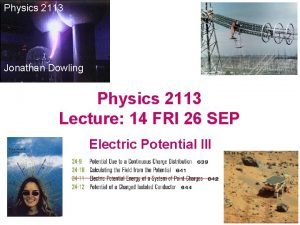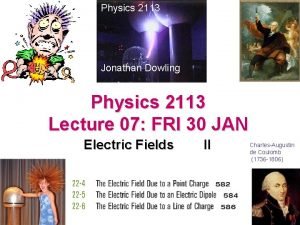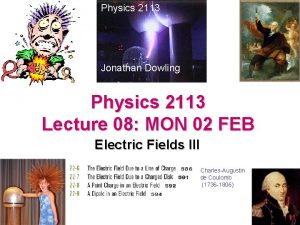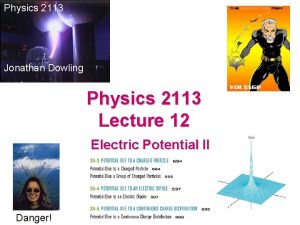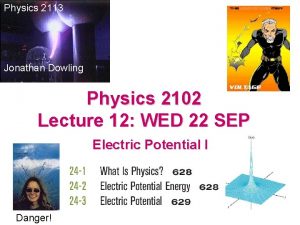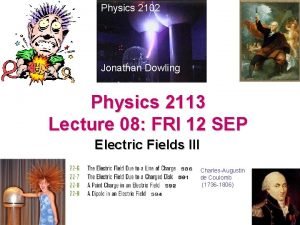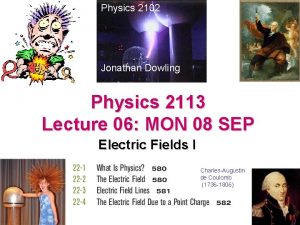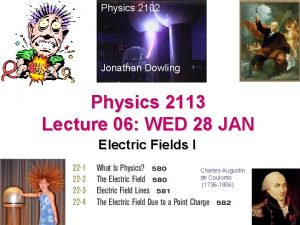Physics 2113 Jonathan Dowling Physics 2113 Lecture 14

![Units : Electric Potential Energy, Electric Potential Energy = U = [J] = Joules Units : Electric Potential Energy, Electric Potential Energy = U = [J] = Joules](https://slidetodoc.com/presentation_image_h/963b5634515374ecf81261a890a10d95/image-2.jpg)


















- Slides: 20

Physics 2113 Jonathan Dowling Physics 2113 Lecture 14: WED 18 FEB Electric Potential II Danger!
![Units Electric Potential Energy Electric Potential Energy U J Joules Units : Electric Potential Energy, Electric Potential Energy = U = [J] = Joules](https://slidetodoc.com/presentation_image_h/963b5634515374ecf81261a890a10d95/image-2.jpg)
Units : Electric Potential Energy, Electric Potential Energy = U = [J] = Joules Electric Potential = V = U/q = [J/C] = [Nm/C] = [V] = Volts Electric Field = E = [N/C] = [V/m] = Volts per meter Electron Volt = 1 e. V = Work Needed to Move an Electron Through a Potential Difference of 1 V: W = qΔV = e x 1 V = 1. 60 10– 19 C x 1 J/C = 1. 60 10– 19 J

Electric Potential Energy = Joules Electric potential energy difference ΔU between two points = work needed to move a charge between the two points: ΔU = Uf – Ui = –W

Electric Potential Voltage = Volts = Joules/Coulomb! Electric potential — voltage! — difference ΔV between two points = work per unit charge needed to move a charge between the two points: ΔV = Vf – Vi = –W/q = ΔU/q

Equal-Potential = Equipotential Surfaces • The Electric Field is Tangent to the Field Lines • Equipotential Surfaces are Perpendicular to Field Lines • Work Is Needed to Move a Charge Along a Field Line. • No Work Is Needed to Move a Charge Along an Equipotential Surface (Or Back to the Surface Where it Started). • Electric Field Lines Always Point Towards Equipotential Surfaces With Lower Potential.

Electric Field Lines and Equipotential Surfaces Why am I smiling? I’m About to Be Struck by Lightning! http: //www. cco. caltech. edu/~phys 1/java/phys 1/EField. html

Conservative Forces The potential difference between two points is independent of the path taken to calculate it: electric forces are “conservative”.

Electric Potential of a Point Charge Bring imaginary + test charge q 0 in from infinity! Note: if q were a negative charge, V would be negative If q 0 and are both + charges as shown, is the Work needed to bring q 0 from ∞ to P + or –?

Electric Potential of Many Point Charges • Electric potential is a SCALAR not a vector. q 4 • Just calculate the potential due to each individual point charge, and add together! (Make sure you get the SIGNS correct!) r 3 r 4 q 5 r 5 Pr 2 q 2 r 1 q 3

No vectors! Just add with sign. One over distance. Since all charges same and all distances same all potentials same.

ICPP: Positive and negative charges of equal magnitude Q are held –Q +Q in a circle of radius r. 1. What is the electric potential voltage at the center of each circle? A • VA = • VB = • VC = 2. Draw an arrow representing the approximate direction of B the electric field at the center of each circle. 3. Which system has the highest potential energy? UA =+q 0 VA has largest positive un-canceled charge C

Potential Energy of A System of Charges • 4 point charges (each +Q and equal mass) are connected by strings, forming a square of side L • If all four strings suddenly snap, what is the kinetic energy of each charge when they are very far apart? +Q +Q • Use conservation of energy: – Final kinetic energy of all four charges = initial potential energy stored = energy required to assemble the system of charges – If each charge has mass m, find the velocity of each charge long after the string snaps. Let’s do this from scratch!

Potential Energy of A System of Charges: Solution • No energy needed to bring in first charge: U 1=0 +Q L +Q • Energy needed to bring in 2 nd charge: • Energy needed to bring in 3 rd charge = • Energy needed to bring in 4 th charge = +Q +Q Total potential energy is sum of all the individual terms shown on left hand side = So, final kinetic energy of each charge =K=mv 2/2 =

Potential Energy of a Dipole +Q a What is the potential energy of a dipole? –Q +Q a –Q • First: Bring charge +Q: no work involved, no potential energy. • The charge +Q has created an electric potential everywhere, V(r) = k. Q/r • Second: The work needed to bring the charge –Q to a distance a from the charge +Q is Wapp = U = (-Q)V = (–Q)(+k. Q/a) = -k. Q 2/a • The dipole has a negative potential energy equal to -k. Q 2/a: we had to do negative work to build the dipole (electric field did positive work).

Electric Potential of a Dipole (on axis) What is V at a point at an axial distance r away from the midpoint of a dipole (on side of positive charge)? p a –Q +Q r Far away, when r >> a: V

IPPC: Electric Potential on Perpendicular Bisector of Dipole You bring a charge of Qo = – 3 C from infinity to a point P on the perpendicular bisector of a dipole as shown. Is the work that you do: a) Positive? b) Negative? c) Zero? U = Qo. V = Qo(–Q/d+Q/d) = 0 a -Q +Q d P – 3 C


Summary: • Electric potential: work needed to bring +1 C from infinity; units V = Volt • Electric potential uniquely defined for every point in space -- independent of path! • Electric potential is a scalar — add contributions from individual point charges • We calculated the electric potential produced by a single charge: V=kq/r, and by continuous charge distributions: d. V=kdq/r • Electric potential energy: work used to build the system, charge by charge. Use W=q. V for each charge.

Midterm Exam #1 • • • AVG = 67; STDV=17 A: 90 -100% B: 75 -89% C: 60 -74% D: 50 -59% F: 49 -0%

 Jonathan dowling
Jonathan dowling E=q/ae0
E=q/ae0 Shock mnemonic
Shock mnemonic Dowling optical
Dowling optical Dowling roundabout
Dowling roundabout International human resource management dowling 6th edition
International human resource management dowling 6th edition Comp 2113
Comp 2113 Art 2113 cc
Art 2113 cc Afi first sergeant
Afi first sergeant 01:640:244 lecture notes - lecture 15: plat, idah, farad
01:640:244 lecture notes - lecture 15: plat, idah, farad Phy101 lecture 1
Phy101 lecture 1 Physics 101 lecture notes pdf
Physics 101 lecture notes pdf Physics 111 lecture notes
Physics 111 lecture notes Atmospheric physics lecture notes
Atmospheric physics lecture notes Waves physics notes pdf
Waves physics notes pdf Physics 101 lecture
Physics 101 lecture Why does it happen
Why does it happen University physics with modern physics fifteenth edition
University physics with modern physics fifteenth edition Ib physics ia ideas
Ib physics ia ideas Jonathan smart ofsted
Jonathan smart ofsted David jonathan linton
David jonathan linton
